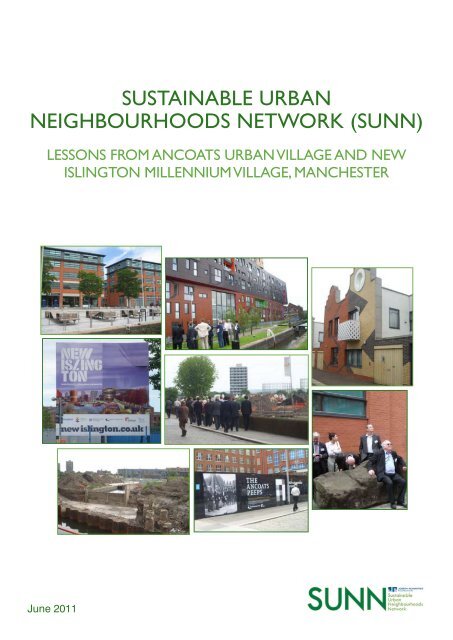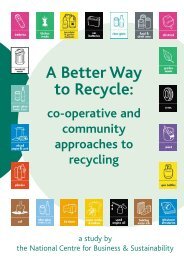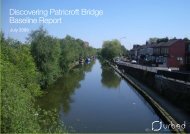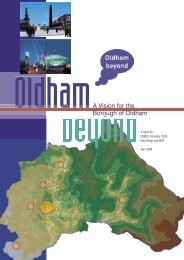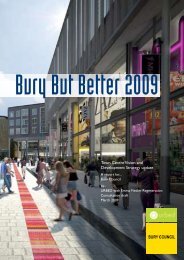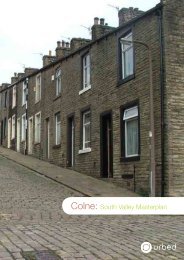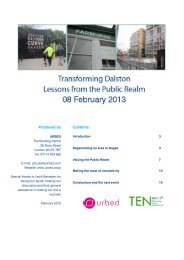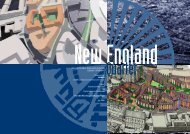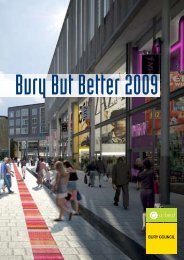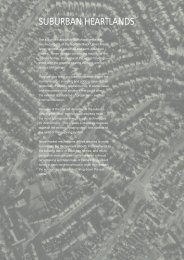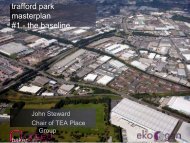Ancoats and New Islington report.pdf - Urbed
Ancoats and New Islington report.pdf - Urbed
Ancoats and New Islington report.pdf - Urbed
Create successful ePaper yourself
Turn your PDF publications into a flip-book with our unique Google optimized e-Paper software.
SUSTAINABLE URBAN<br />
NEIGHBOURHOODS NETWORK (SUNN)<br />
LESSONS FROM ANCOATS URBAN VILLAGE AND NEW<br />
ISLINGTON MILLENNIUM VILLAGE, MANCHESTER<br />
June 2011
Source: Martin Stockley Associates
SUSTAINABLE URBAN<br />
NEIGHBOURHOODS NETWORK (SUNN)<br />
Report of the <strong>Ancoats</strong> <strong>and</strong> <strong>New</strong> <strong>Islington</strong> Event<br />
28 th June 2011<br />
Contents<br />
Setting the Scene 1<br />
Eco-Urban Renewal: Beyond a Tick Box Approach 7<br />
Study Tour Findings 8<br />
<strong>Ancoats</strong> Urban Village 8<br />
<strong>New</strong> <strong>Islington</strong> Millennium Village 9<br />
Workshop Findings 10<br />
1. Incorporating environmental sustainability<br />
into building <strong>and</strong> urban design 10<br />
2. Achieving a balanced, mixed tenure community 11<br />
3. Cutting-edge public realm <strong>and</strong> roadway initiatives<br />
in <strong>Ancoats</strong> <strong>and</strong> <strong>New</strong> <strong>Islington</strong> 14<br />
Next Steps 18<br />
Appendix A – List of Delegates 19<br />
Photos courtesy of Urban Splash, Martin<br />
Stockley Associates, Nick Dodd, Mike Vout,<br />
Michael Carley & URBED
<strong>Ancoats</strong> Study Area<br />
Source: Martin Stockley Associates<br />
<strong>New</strong> <strong>Islington</strong> Framework Plan<br />
Source: Urban Splash
<strong>Ancoats</strong> & NEW ISLINGTON EVENT 28 TH JUNE 2011<br />
SUSTAINABLE URBAN NEIGHBOURHOODS NETWORK<br />
LESSONS FROM ANCOATS URBAN VILLAGE AND NEW<br />
ISLINGTON MILLENNIUM VILLAGE, MANCHESTER<br />
The main focus of the network’s Manchester meeting was on environmental<br />
sustainability, balanced communities, <strong>and</strong><br />
cutting edge public realm initiatives. This<br />
<strong>report</strong> summarises some inspirational talks<br />
<strong>and</strong> constructive workshop discussions. In<br />
terms of our ‘walk about’, SUNN team<br />
members were blessed with a fine day to see<br />
some impressive achievements.<br />
Photographs of the visit can be found on<br />
Basecamp, along with the main PowerPoint<br />
presentations.<br />
SETTING THE SCENE<br />
A factual briefing note on <strong>Ancoats</strong> had been provided by Mark Canning, Project<br />
Manager with the North West Development Agency, <strong>and</strong> a briefing paper <strong>and</strong> project<br />
sheets on <strong>New</strong> <strong>Islington</strong> from Great Places, who are the lead housing association<br />
<strong>and</strong> responsible for much of the new housing to date. Introductory presentations<br />
were given by John Hocking, Executive Director of the Joseph Rowntree Housing<br />
Trust on emerging challenges in the new political context, by Richard Hattan,<br />
Development Director of Urban Splash, who are lead developers in <strong>New</strong> <strong>Islington</strong>,<br />
<strong>and</strong> by Stephen O’Malley, Director at Martin Stockley Associations, who are the<br />
engineers responsible for the public realm in <strong>Ancoats</strong>.<br />
John Hocking stressed how much has changed over the past few years. This means<br />
that radically different approaches must be considered if we are to build the housing<br />
that is needed. Among John’s key points:<br />
• There was a hiatus in the Planning system as the Localism Bill progresses<br />
through the legislative timetable. In many areas development has stalled <strong>and</strong><br />
despite some good models, there are real problems in ‘going to scale’, that is<br />
building the kinds of numbers that are really needed to meet forecasts of housing<br />
dem<strong>and</strong>.<br />
• Rising rents are eroding the hopes of young people trying to save the deposits<br />
needed to buy a home. The national Housing benefit bill had risen to £22b <strong>and</strong><br />
significant changes were being introduced to reduce this at a time when the<br />
1
<strong>Ancoats</strong> & NEW ISLINGTON EVENT 28 TH JUNE 2011<br />
Government were introducing near market rents, which in York doubled the<br />
current rent for a three bedroom house, <strong>and</strong> increased dependency on Housing<br />
benefits.<br />
• It is vital to find a way out of this ‘maze’, for example by making full use of publicly<br />
owned l<strong>and</strong> with infrastructure in place.<br />
Key issues still to be tackled include:<br />
• Where is the finance coming from for first<br />
time buyers, <strong>and</strong> who is going to build<br />
affordable homes for them?<br />
• How can we ‘future proof’ developments in<br />
terms of energy <strong>and</strong> transport without<br />
importing all the technology from abroad?<br />
In the next presentation, Richard Hattan<br />
suggested that <strong>New</strong> <strong>Islington</strong> is a valuable<br />
model for other authorities faced with the<br />
problem of regenerating an inner city industrial<br />
area close to the heart of a major city, <strong>and</strong><br />
creating an attractive place to live:<br />
• ‘The challenge was to change one of the worst areas in Manchester into one of<br />
the best’.<br />
• <strong>New</strong> <strong>Islington</strong> is developing the old Cardroom Estate on 33 acres of l<strong>and</strong> owned<br />
by Manchester City Council, <strong>and</strong> only 102 of the original 200 homes were still<br />
lived in when the project started.<br />
• The development team felt it was<br />
important to build on strengths, which<br />
were a sense of community <strong>and</strong> an<br />
attractive canal network.<br />
• <strong>New</strong> <strong>Islington</strong> directly adjoins <strong>Ancoats</strong>,<br />
just the other side of the Rochdale<br />
Canal, which is a unique part of the<br />
world’s industrial heritage. Linking the<br />
two communities is an important part<br />
of the brief.<br />
An inspirational masterplan by Will Alsop provides the basis for comprehensive<br />
development:<br />
2
<strong>Ancoats</strong> & NEW ISLINGTON EVENT 28 TH JUNE 2011<br />
• Work started in 2003 to create new canals <strong>and</strong> a water park, <strong>and</strong> approximately<br />
100,000 tons of l<strong>and</strong> has been decontaminated <strong>and</strong> reused onsite; the process<br />
took five years <strong>and</strong> a significant part of the public investment.<br />
• The scheme is designed to be a real mix: ‘It’s all in the mix – uses, people,<br />
incomes, tenures’ to avoid the problems of ‘us <strong>and</strong> them’.<br />
• A significant feature has been the Sustainability Plan, which was implemented<br />
well before they became st<strong>and</strong>ard practice. It requires:<br />
- Minimum construction waste<br />
- Recyclable materials<br />
- Low embodied energy<br />
- Renewable energy <strong>and</strong> resources<br />
• The most prominent building so far is<br />
‘Chips’ a striking block of flats designed by<br />
Will Alsop <strong>and</strong> the first homes for public<br />
sale. 142 of the 150 apartments are<br />
occupied, plus a couple of the commercial<br />
units on the ground floor.<br />
• The scheme went beyond Eco-homes<br />
Excellent, with an energy centre in the<br />
Chips Apartment block that can serve the<br />
wider site, giving residents the option of<br />
district heating.<br />
• The first phase of social housing, <strong>Islington</strong><br />
Square, completed in 2006 gave the 23<br />
households the opportunity to select from a<br />
shortlist the architect for their homes. Much to<br />
the surprise of the developer they choose the<br />
wildcard FAT (Fashion Architecture Taste). FAT<br />
were the only ones who didn’t give a st<strong>and</strong>ard<br />
formal presentation <strong>and</strong> instead sat down with<br />
the community <strong>and</strong> listened to what they wanted.<br />
This approach gained the trust of the residents<br />
<strong>and</strong> won the commission. Residents wanted<br />
traditional housing <strong>and</strong> by this they meant being<br />
able to park their car off the street <strong>and</strong> be able to<br />
see it from their living rooms. They wanted<br />
kitchens at the back of the house, not at the front<br />
as they had before, <strong>and</strong> they wanted private back gardens. Some participants<br />
raised concerns about the quality of the design <strong>and</strong> how well the properties would<br />
age.<br />
3
<strong>Ancoats</strong> & NEW ISLINGTON EVENT 28 TH JUNE 2011<br />
• Initial projects are helping to change the area’s image <strong>and</strong> win community<br />
support, for example through design competitions for housing to replace what<br />
was being demolished <strong>and</strong> festivals that have attracted thous<strong>and</strong>s, both local<br />
residents <strong>and</strong> people from outside ‘You can’t make a proper place unless you’re<br />
having fun’.<br />
• A ‘one move strategy’ was implemented for some of the existing Cardroom<br />
Estate residents (mainly elderly persons) who could not face more then one<br />
move.<br />
• Twelve existing homes have been retained<br />
on Weybridge Road - after residents fought<br />
to keep their homes which had been<br />
earmarked for demolition. These formed<br />
Manchester's smallest stock transfer to an<br />
RSL.<br />
• Site preparation has been completed <strong>and</strong> the<br />
bulk of houses have been knocked down.<br />
The project is now on the final phase of the re-housing process <strong>and</strong> will soon be<br />
completing public realm investments, including a new park <strong>and</strong> a marina.<br />
• A site has been allocated for self-build units, with detailed planning permission,<br />
but this project is stalled due to economic circumstances. A block of 200 units by<br />
Taylor Wimpey is also on hold.<br />
The lessons on ‘what works’ include:<br />
• Effective partnership working between<br />
the l<strong>and</strong>owner, master developer <strong>and</strong><br />
other public agencies including the<br />
HCA, <strong>New</strong> East Manchester Ltd <strong>and</strong><br />
Great Places.<br />
• A masterplan that makes the most of<br />
existing <strong>and</strong> new canals, thus<br />
reflecting the area’s history, with a<br />
new park acting as a buffer between<br />
the housing <strong>and</strong> an existing, unattractive retail park.<br />
• Reuse <strong>and</strong> recycling of both buildings <strong>and</strong> materials.<br />
• A design code which secures higher st<strong>and</strong>ards than would normally have been<br />
achieved.<br />
Some things which did not work so well included:<br />
• Some new technologies, such as private wire networks<br />
4
<strong>Ancoats</strong> & NEW ISLINGTON EVENT 28 TH JUNE 2011<br />
• Complex household energy bills/service charges<br />
• The financial case for water technologies, such as grey water recycling.<br />
In conclusion Richard asked: ‘So do we really want a mix, <strong>and</strong> if so, how do we get<br />
it?’ One possible solution used by Great Places when they took over the Vibe in<br />
Salford, was to let the housing to economically active people with ambition to<br />
purchase in 3-5 years, <strong>and</strong> who could afford strong full-time management, rather<br />
than taking people with the maximum points on Council waiting lists.<br />
<strong>New</strong> East Manchester<br />
The regeneration of <strong>Ancoats</strong> <strong>and</strong> the old Cardroom Estate had been under<br />
consideration for decades. What made it possible was the provision of grant<br />
funding for site assembly, decontamination, environmental works <strong>and</strong><br />
planning (in a similar way to the model used on the Continent in places like<br />
Amersfoort). A company dedicated to the regeneration of the two<br />
neighbourhoods was funded through the North West Development Agency,<br />
<strong>and</strong> drew in private developer <strong>and</strong> social housing partners. By using the<br />
RDA’s compulsory purchase powers, in 2002 197 different l<strong>and</strong> ownerships<br />
were brought together, without the need for an approved plan. Some £66<br />
million of public funds were invested, which should be repaid out of the £330<br />
million of private investment that is following. Owners were then able to<br />
reacquire sites if they were in a position to go ahead with development.<br />
Developers today want ‘oven ready’ sites, <strong>and</strong> <strong>New</strong> East Manchester offers a<br />
model that could be applied much more widely to reduce the initial risks, <strong>and</strong><br />
set higher st<strong>and</strong>ards of design.<br />
In a third presentation, Stephen O’Malley explained how the <strong>Ancoats</strong> area had<br />
evolved over several hundred years, <strong>and</strong> how regeneration <strong>and</strong> adaptive reuse were<br />
being promoted through investment in the public realm:<br />
• <strong>Ancoats</strong> occupies some 50<br />
acres due north of<br />
Manchester Piccadilly<br />
Station, <strong>and</strong> only a short<br />
walk from the city centre.<br />
• Development started in<br />
1787 <strong>and</strong> was largely<br />
complete by 1848, taking<br />
advantage of the new<br />
Rochdale Canal to bring in<br />
supplies of cotton <strong>and</strong> coal<br />
to provide power. By the<br />
Evolution of <strong>Ancoats</strong> village – slide taken from Stephen<br />
O’Malley’s presentation<br />
5
<strong>Ancoats</strong> & NEW ISLINGTON EVENT 28 TH JUNE 2011<br />
1820s, <strong>Ancoats</strong> was a pioneer of steam-powered<br />
industry.<br />
• In the 20th century, buildings decayed as industry<br />
closed down, <strong>and</strong> by 2002 most activity had gone, with<br />
empty sites <strong>and</strong> low value uses such as warehousing.<br />
Articles in the press argued for clearing the whole site<br />
<strong>and</strong> using it for car parking.<br />
• As part of a comprehensive regeneration strategy, a<br />
public realm strategy drew on both an archaeological<br />
appraisal <strong>and</strong> an assessment of how to change the<br />
dysfunctional, over-complex one way system while<br />
respecting the historic character of <strong>Ancoats</strong>.<br />
• The strategy divided the area into four types of<br />
street requiring different approaches aimed at<br />
changing road users behaviour rather than<br />
enforcing regulations; thus the pavements have<br />
only a 75mm upst<strong>and</strong>, <strong>and</strong> there are ‘no priority<br />
junctions’ without sight lines, completely going<br />
against the conventional wisdom of highway design.<br />
• An artist formed a crucial part of the team, responsible for helping to link the past<br />
<strong>and</strong> the future.<br />
Some £12 million out of a total grant of £65<br />
million was invested in the public realm, which<br />
has transformed the appearance of the area. As<br />
a result developers are much more interested in<br />
<strong>Ancoats</strong> than previously. In part this is because<br />
they now have access to what has been<br />
described as ‘oven ready’ sites, that is sites<br />
ready to go in terms of basic infrastructure,<br />
sound building shells, <strong>and</strong> clear planning<br />
permission.<br />
The briefing demonstrated a good return on the initial public investment as the<br />
scheme will provide overall:<br />
• 1,800 new residential units.<br />
• 60,000 sq m of new commercial floor space equating to 1,900 new jobs (many<br />
more than were previously there).<br />
• Some £330 million of private investment or five times the public investment.<br />
6
<strong>Ancoats</strong> & NEW ISLINGTON EVENT 28 TH JUNE 2011<br />
• Investment has been carefully targeted, for example restoring roofs <strong>and</strong> using the<br />
best materials, such as setts so that they enhance development, while providing<br />
a degree of variety.<br />
ECO-URBAN RENEWAL: BEYOND A TICK BOX APPROACH<br />
Manchester has been the scene of many other innovative regeneration projects,<br />
such as in Hulme <strong>and</strong> Castlefield, as well as the city centre, <strong>and</strong> Nick Dodd,<br />
Sustainability Consultant at URBED, presented some lessons from projects around<br />
Europe to show what could be done.<br />
• The main challenge for regeneration is<br />
how to attract families to live at higher<br />
densities, <strong>and</strong> the consequent benefits<br />
from economies of scale in transport,<br />
energy <strong>and</strong> the public realm.<br />
• The Code for Sustainable Homes<br />
requires Code Level 4 by 2013, <strong>and</strong><br />
level 6 by 2016, with energy<br />
accounting for 36% of the points in the<br />
assessment. This can only be<br />
achieved at a neighbourhood scale,<br />
for example through blocks of terraced<br />
houses that avoid unnecessary walls<br />
or glazing.<br />
• Photovoltaics can be used like a<br />
power station, along with shared<br />
energy centres, which the Association<br />
of Manchester Authorities is<br />
investigating.<br />
• <strong>New</strong> communities should not be seen<br />
in isolation, <strong>and</strong> initiatives like the Green Deal in Northmoor Manchester have<br />
transformed market values, as have projects in Goole East Riding of Yorkshire<br />
<strong>and</strong> Hebedygarde in Copenhagen.<br />
• Day lighting is crucial to making streets liveable, for example through combining<br />
narrow streets with courtyards, <strong>and</strong> the Nottingham Design Guide provides an<br />
analysis of the views that development can open up.<br />
• Green infrastructure is about more than biodiversity as street trees help to keep<br />
temperatures down in Summer, ‘creating a natural edge’.<br />
7
<strong>Ancoats</strong> & NEW ISLINGTON EVENT 28 TH JUNE 2011<br />
Countries like Sweden, which have been seeking to save energy for much longer,<br />
can provide useful lessons, <strong>and</strong> it is important to go beyond the Code for Sustainable<br />
Homes, which is a ‘blunt tool’ <strong>and</strong> take a wider approach that assesses the footprint<br />
of a scheme, <strong>and</strong> responds to the local context:<br />
• In the Expo site of Bo01 in a former ship yard in Malmö, developers have been<br />
asked to choose from a menu of ‘green options’ which had led to an attractive<br />
patchwork of different habitats.<br />
• However, many of the apartment blocks had failed to achieve the energy targets,<br />
due largely to thermal-bridging through balconies, which allow heat to flow out.<br />
• A step change in environmental quality is needed to get people out of their cars,<br />
as in Copenhagen, where enough space is provided not only to cycle in safely to<br />
the centre, but also to store your bike.<br />
• Waste also needs to be thought through, for example allowing for getting rid of<br />
both old sofas <strong>and</strong> organic waste, <strong>and</strong> recycling services are best provided at the<br />
end of streets not in an array of wheelie bins.<br />
• Food can account for 25% of household emissions when all the costs are taken<br />
into account, so we may need to return to markets <strong>and</strong> local provision, which can<br />
also provide valuable meeting points.<br />
STUDY TOUR FINDINGS<br />
<strong>Ancoats</strong> Urban Village<br />
1. Regeneration in Manchester is moving North <strong>and</strong><br />
East from the main railway line, along the old<br />
canals.<br />
2. Developments such as BDP’s headquarter offices<br />
are both helping to change the area’s image <strong>and</strong><br />
are cutting running costs (<strong>and</strong> carbon emissions)<br />
through innovative design.<br />
3. <strong>Ancoats</strong> is one of the oldest industrial areas in the UK, with a grid of multi-storey<br />
cotton mills <strong>and</strong> warehouses, <strong>and</strong> may become a<br />
World Heritage Site.<br />
4. Much of the area had been cleared of activity, <strong>and</strong><br />
was looking derelict <strong>and</strong> dangerous a decade ago.<br />
5. The upgraded public realm makes it much easier<br />
<strong>and</strong> pleasant to walk round the area.<br />
6. The restoration of the old Rochdale Canal, which<br />
runs across the Pennines, has injected new confidence <strong>and</strong> interest into the area.<br />
8
<strong>Ancoats</strong> & NEW ISLINGTON EVENT 28 TH JUNE 2011<br />
7. Sites that are awaiting development have been mothballed <strong>and</strong> face lifted.<br />
8. Considerable effort has gone into the area’s promotion <strong>and</strong> marketing.<br />
9. Imaginative uses of public art include ‘peep holes’ <strong>and</strong> the retention of material<br />
found on the site.<br />
10. Uses such as ‘apartment hotels’ <strong>and</strong> business<br />
space are helping to restore life to the area.<br />
<strong>New</strong> <strong>Islington</strong> Millennium Village<br />
1. The main idea in the masterplan is making the<br />
most of water through new canal basins.<br />
2. Key principles include ‘nature into the city’, ‘views<br />
over water’ <strong>and</strong> ‘sustainable construction’.<br />
3. Some of the existing housing blocks have been<br />
retained <strong>and</strong> upgraded at a cost of £30,000 per<br />
home.<br />
4. <strong>New</strong> homes have been built to imaginative designs<br />
chosen by the community at a cost of around<br />
£175,000 per home but there was a question mark over how attractive the<br />
bespoke design would be to future residents.<br />
5. <strong>Islington</strong> Square provided a strong marketing<br />
image that the area is changing for the<br />
better.<br />
6. Guest Street the second stage of social<br />
housing, designed by DeMetz Forbes Knight<br />
is a contemporary interpretation of traditional<br />
terraced houses, inspired by visits to<br />
Amsterdam. The 14 houses are designed to<br />
receive an Eco-Homes Excellent Rating <strong>and</strong><br />
feature sedum-planted roofing.<br />
7. The unusual design of the Chips building<br />
(named so because it looks like three chunky<br />
chips stacked on top of each other) contrasts<br />
with more conventional forms of new housing<br />
provided by developers working on the other<br />
side of the canal.<br />
8. Distinctive lighting columns have been used to give the area a special identity.<br />
9. Local resistance to non residents parking in the centre of the street (which was<br />
thought to be unsafe) has led to spaces being blocked off.<br />
9
<strong>Ancoats</strong> & NEW ISLINGTON EVENT 28 TH JUNE 2011<br />
10. The paviour surfaces have effectively calmed the traffic. However, they have not<br />
been properly maintained, <strong>and</strong> may be asphalted over.<br />
WORKSHOP FINDINGS<br />
1. Incorporating environmental sustainability into building <strong>and</strong> urban<br />
design<br />
This workshop considered the most cost-effective ways to maximise energy<br />
efficiency, what has not worked so well, <strong>and</strong> how to plan more holistically for both<br />
embodied <strong>and</strong> operating energy consumption.<br />
The easiest ways of saving energy identified in discussion are:<br />
• Reusing existing buildings <strong>and</strong> recycling materials from demolition on site.<br />
• Building well-insulated buildings, which include terraced housing <strong>and</strong> multi-storey<br />
blocks. For example, the Energy Saving Trust’s guide to Sustainable<br />
Refurbishment recommends ‘build tight <strong>and</strong> ventilate right’.<br />
• Bulk buying <strong>and</strong> bulk provision, such as district heating, can cut energy costs, for<br />
example through an energy centre <strong>and</strong> a district heating scheme, which requires<br />
ducts <strong>and</strong> pipes to be installed before development takes place.<br />
• Systems should allow for several energy sources e.g. biomass with gas as<br />
backup.<br />
However, problems can arise with district heating due to:<br />
• The need for higher levels of up front investment, which may not be recovered if<br />
the building rate is not maintained <strong>and</strong> development has to be phased.<br />
• Resistance of utilities to sharing ducts <strong>and</strong> also providing connections if they lose<br />
part of their market.<br />
• Difficulties of convincing prospective owner occupiers or residents of the benefits<br />
of alternative forms of behaviour or life styles, for example, house purchasers<br />
expect homes to have individual central heating boilers.<br />
In terms of promoting energy efficiency the following approaches may help:<br />
• Using Sustainability Plans to achieve higher st<strong>and</strong>ards<br />
• Changing VAT to encourage recycling of buildings - Urban Splash are leading a<br />
campaign on this.<br />
• Setting up an independent body on-site to promote the personal economic<br />
benefits of different life style approaches, for example, giving up car ownership in<br />
favour of car clubs membership.<br />
10
<strong>Ancoats</strong> & NEW ISLINGTON EVENT 28 TH JUNE 2011<br />
• Using local networking <strong>and</strong> social media to influence behaviour by focussing on<br />
the savings in running costs e.g. The TripAdvisor website shares customer<br />
experience of hotels<br />
• Developing Energy Performance Certificates as a marketing device now that<br />
buildings have to be tested for air tightness (rather as car manufactures<br />
responded to higher fuel prices through diesel engines, or appliance<br />
manufacturers provide energy ratings at the point of sale).<br />
• Using better (industry wide?) marketing to promote ‘green homes’ <strong>and</strong> ‘green<br />
neighbourhoods’ (perhaps through providing higher loans to value ratios at a<br />
lower interest rate via the proposed Green Infrastructure Bank.<br />
<strong>New</strong> <strong>Islington</strong>’s Sustainability Plan<br />
<strong>New</strong> <strong>Islington</strong>, as Manchester’s designated ‘millennium village’, has sought to test out<br />
higher environmental st<strong>and</strong>ards. A plan was commissioned by developers Urban<br />
Splash that set out targets along with proposals for monitoring <strong>and</strong> ideas on how the<br />
targets could be achieved, along with sources of information on each of these. The<br />
idea was that is should be used by English Partnerships in selling off sites. The plan<br />
covered:<br />
• Primary energy consumption, through CHP, higher fabric insulation st<strong>and</strong>ards (U<br />
values), <strong>and</strong> better lighting <strong>and</strong> boiler st<strong>and</strong>ards<br />
• Embodied energy, through the use of the BRE’s Green Guide to Housing<br />
Specification<br />
• Mains water consumption through the use of bore hall sources, draining rainwater<br />
into the canal<br />
• Waste management through pre-sorted waste collection for recycling, with<br />
‘separation facilities’ in every dwelling<br />
• Defects through the use of modular construction <strong>and</strong> prefabrication where<br />
appropriate<br />
• Dwelling size through a mix, with minimum sizes for small (2 bed homes) of<br />
65m,<strong>and</strong> larger 2 beds 80m2 with 3 bed homes of 100m2<br />
• Day lighting through buildings arranged in fingers around the sun’s path to<br />
minimise shadowing<br />
• Noise proofing through better insulation<br />
• Construction waste through crushing <strong>and</strong> recycling materials from demolition on<br />
site, <strong>and</strong> through prefabrication<br />
• Site safety through attention at tendering<br />
• Information Technology through access to the internet in all the main rooms<br />
2. Achieving a balanced, mixed tenure community<br />
This workshop began with discussion of the meaning of the terms ‘mixed’ <strong>and</strong><br />
‘balanced’ with reference to communities. They could be ‘mixed’ in terms of tenures,<br />
household incomes, sizes of property in terms of number of bedrooms <strong>and</strong> in terms<br />
of location, as in pepper-potted communities. There was agreement that the notion<br />
of mixing tenures arose first within the regeneration field to address the problems of<br />
11
<strong>Ancoats</strong> & NEW ISLINGTON EVENT 28 TH JUNE 2011<br />
mono-tenure public housing estates, particularly where dysfunctional households<br />
had been concentrated on deprived estates. Here a mixing of tenures by providing<br />
opportunities for owner occupation had indeed helped the regeneration process, not<br />
least by enabling local residents in work to remain in their communities while also<br />
achieving aspirations for owner occupation. But it was also noted that there many<br />
‘unmixed’ communities, such as wealthier neighbourhoods, which functioned<br />
perfectly well from the residents point of view. It was also noted, with reference to<br />
research in Glasgow, that mixing tenures did not necessarily lead to social mixing<br />
between households of different income levels.<br />
Discussion of the concept of ‘balanced’ communities was more challenging but<br />
fruitful. Although at the outset what constituted a ‘balanced community’ per se was<br />
hard to define, there is ready underst<strong>and</strong>ing of the characteristics of ‘unbalanced’<br />
communities: concentration of poverty, excessive crime or anti-social behaviour,<br />
neighbourhood stigma, depressed property values, social tensions, overconcentration<br />
of certain tenures - such as too many student lets or houses in multiple<br />
occupation (HMOs), excessive turnover or ‘churn’ of residents, poor estate or<br />
neighbourhood management, lack of social development activity <strong>and</strong> so on. The<br />
symptoms of ‘unbalancedness’ can range from too much crime to poor car parking<br />
arrangements, in short, any issue which detracts from the residents’ quality of life.<br />
Wherever such unbalanced characteristics reduce quality of life in neighbourhoods<br />
<strong>and</strong> on estates, a move back toward balance is required by intervention <strong>and</strong><br />
beneficial management. So a balanced community is one where the necessary<br />
intervention <strong>and</strong> management mechanisms are in place to address symptoms of<br />
‘unbalancedness’ as they arise. A balanced community is robust <strong>and</strong> resilient with<br />
sufficient stability for quality of life, at best for a range of households including young<br />
people, families with children <strong>and</strong> elderly people. Here the concepts of ‘balanced’<br />
<strong>and</strong> ‘mixed’ come together to suggest that communities benefit from the social<br />
equivalent of biodiversity. But such mixed communities may require intervention <strong>and</strong><br />
management to succeed. The initiative of the JRHT to bridge the gap between<br />
teenagers ‘hanging out’ <strong>and</strong> elderly residents in <strong>New</strong> Earswick was cited as a good<br />
example of active management. The point was also made that what should be<br />
designed for is ‘lifetime neighbourhoods’ but not necessarily lifetime homes which<br />
are often poorly designed in terms of the needs of most non-elderly residents. At the<br />
neighbourhood level, management can also be important to prevent some areas<br />
from ‘going downhill quickly’. An example of the need to license HMOs in seaside<br />
towns was cited.<br />
The characteristics of active, positive management were discussed. It was first noted<br />
that the requirement for active management existed at both the level of the street or<br />
block of flats, <strong>and</strong> at the level of the neighbourhood. Management was for two broad<br />
12
<strong>Ancoats</strong> & NEW ISLINGTON EVENT 28 TH JUNE 2011<br />
purposes: to exert control over socially dysfunctional activities before they could<br />
destabilise the building or the neighbourhood, i.e. social control; <strong>and</strong> to promote<br />
quality of life at the household <strong>and</strong> neighbourhood level, through social development,<br />
as in the <strong>New</strong> Earswick example given above.<br />
Many different examples of positive management arrangements were cited from<br />
within SUNN member neighbourhoods. Management functions could be carried out<br />
by a variety of organisations, for example, social l<strong>and</strong>lords in the case of <strong>New</strong><br />
<strong>Islington</strong> or <strong>New</strong> Earswick, a private sector management company working on behalf<br />
of residents as in Gr<strong>and</strong> Union Village or a formal Parish Council as in Orchard Park.<br />
It was noted that higher density neighbourhoods were likely to be more sustainable<br />
in terms of supporting provision of public transport, schools, shops <strong>and</strong> other<br />
community facilities but such communities might also require more in the way of<br />
positive management.<br />
Whatever the organisational arrangements, certain factors were cited as contributing<br />
to positive management. First, the management team needed to be on-site <strong>and</strong><br />
familiar with, <strong>and</strong> to, residents, not at some arms-length location. Just one or two<br />
good people, with the community’s interests at heart, could make a huge difference<br />
to local quality of life. On-site managers are very much like the community wardens<br />
introduced in a number of regeneration initiatives. On-site managers also need good<br />
‘people skills’ <strong>and</strong> an underst<strong>and</strong>ing that all local residents, even teenagers <strong>and</strong><br />
raucous students, are ‘stakeholders’ in the neighbourhood <strong>and</strong> may need to be<br />
drawn into management processes.<br />
Second, management arrangements worked best when options were considered<br />
<strong>and</strong> then arrangements built-in at the design stage of new communities. This is often<br />
necessary to secure provision for future management <strong>and</strong> maintenance activities<br />
<strong>and</strong> resources for those within deeds <strong>and</strong> leases from the outset, <strong>and</strong> to put in place<br />
restrictive covenants which enable control of anti-social behaviour. Third, transitional<br />
arrangements need to be put in place during the period the first residents are moving<br />
in, not least because they may well be moving into a building site. The harmony of<br />
the neighbourhood in its early days, <strong>and</strong> the experiences of its first residents, may<br />
well influence subsequent sales. The challenges faced by Orchard Park in its early<br />
days were mentioned. Finally, if neighbourhood management is intended, initiatives<br />
need to fit in with local governance arrangements, for example, development of<br />
Parish Councils.<br />
In the final stage of discussion, the question was poised about whether ‘pepperpotting’,<br />
that is, placement of social tenants mixed with owner-occupiers on estates<br />
was beneficial in terms of housing management <strong>and</strong> community well-being. There<br />
was no resolution of the question but advantages <strong>and</strong> disadvantages were noted on<br />
13
<strong>Ancoats</strong> & NEW ISLINGTON EVENT 28 TH JUNE 2011<br />
both sides. On the one h<strong>and</strong>, pepper-potting could certainly reduce any stigma which<br />
might be attached to social tenants being concentrated in one or more buildings in a<br />
less attractive location on an estate. However it was noted that pepper-potting need<br />
not be necessary if design was ‘tenure blind’, meaning that the tenure was not<br />
obvious from an external view.<br />
Pepper-potting was said to create ‘logistical problems’ in terms of management <strong>and</strong><br />
maintenance, which might be more efficient if owner-occupiers <strong>and</strong> social tenants<br />
were in discrete buildings. But a risk was noted of concentrating households with<br />
some type of dysfunction, such as substance abuse, giving rise to both reinforcing<br />
anti-social behaviour <strong>and</strong> stigma.<br />
3. Cutting-edge public realm <strong>and</strong> roadway initiatives in <strong>Ancoats</strong> <strong>and</strong><br />
<strong>New</strong> <strong>Islington</strong><br />
In these two run-down regeneration areas, investment in the public realm was seen<br />
as an important step towards transforming public perceptions <strong>and</strong> confidence in the<br />
area as a positive place to live, work <strong>and</strong> invest.<br />
In <strong>Ancoats</strong>, before the regeneration got underway, the road system was a<br />
convoluted one way system with an excess of signage. These one way streets<br />
encouraged ‘rat running’, particularly by van drivers who knew the area <strong>and</strong> would rip<br />
through the streets at up to 50 miles per hour. The project designers for <strong>Ancoats</strong><br />
decided to take a very different perspective by recognising that the mainly grid road<br />
pattern for the neighbourhood was at the core of the neighbourhood’s public realm<br />
<strong>and</strong> therefore needed to be retained <strong>and</strong> enhanced but in a way which contributed to<br />
visual urban quality, pedestrian <strong>and</strong> cyclist safety while serving roadway functions.<br />
At the same time this once-stigmatised neighbourhood would be in intense<br />
competition with many nearby city-centre development sites for inward investment. A<br />
very high quality public realm, with the road system at its heart, was seen as key<br />
design tactic to establish the neighbourhood’s attractiveness. Even though <strong>Ancoats</strong>’<br />
public realm investments were made at a time of optimism <strong>and</strong> more resources for<br />
regeneration, achieving the intended quality still required substantial advocacy on<br />
the part of the project team to avoid a ‘watering down’ of the quality of the public<br />
realm.<br />
The public realm strategy for <strong>Ancoats</strong>’ has three key components. First, a new public<br />
square was constructed at the heart of the community on the site of some run-down,<br />
dispensable sheds. Cutting Room Square is the first public square in <strong>Ancoats</strong>. The<br />
Square is marked by five giant concrete sentinels containing striking photos taken in<br />
ab<strong>and</strong>oned cutting <strong>and</strong> pattern rooms in the nearby, historic Royal Mills. Eventually<br />
Cutting Room Square will be surrounded by buildings with retail <strong>and</strong> restaurant uses<br />
14
<strong>Ancoats</strong> & NEW ISLINGTON EVENT 28 TH JUNE 2011<br />
at ground floor <strong>and</strong> residential above. It has been completed now for 3-4 years <strong>and</strong><br />
participants commented on how well it is holding up.<br />
Second, the design pays careful attention to the quality of the historic streetscape. At<br />
street level, to reduce visual clutter, signage was to be kept to a minimum. Diverse<br />
but historically-appropriate paving materials identify a hierarchy of road types <strong>and</strong><br />
streetscape design encourages slower driving. Open access intersections mix<br />
pedestrians <strong>and</strong> car drivers in a way which fosters appropriate behaviour <strong>and</strong> slower<br />
speeds. Junction design is intended to inject a degree of uncertainty into the driver’s<br />
mind about the intention of other road users so that they drive more carefully <strong>and</strong><br />
slowly. In addition, posters have been put up in local delivery depots to educate van<br />
drivers towards more responsible behaviour.<br />
Third, an arts programme was set up which served the development <strong>and</strong> made a<br />
point of linking new activities with the long history of an area which includes some of<br />
the first steam-powered mills in the world. This programme includes unusual<br />
‘sculptures’ called ‘The Peeps’ which are viewed through a series of brass eye<br />
pieces built into the walls of <strong>Ancoats</strong>’ historic mills. Each gives a glimpse into a<br />
space that has been walled up. There are no plaques or a set route, they are<br />
discovered as you explore the area. The peep holes are described as ‘slippages<br />
through time’.<br />
In terms of parking arrangements, a listed building in <strong>Ancoats</strong> is to be converted into<br />
a multi storey car park. Other parking is provided by a mix of on-street, ground floor<br />
<strong>and</strong> basement. Street parking arrangements will reduce some <strong>Ancoats</strong>’ roadways<br />
down to a single carriageway which should also help manage speeds. But, as many<br />
buildings <strong>and</strong> sites remain undeveloped, there is little requirement for parking spaces<br />
as yet <strong>and</strong> the strategy will only take effect once more residents have moved in. With<br />
the benefit of hindsight, it would have been better to mark out on-road parking areas<br />
with planting <strong>and</strong>/or bollards, thus achieving the carriageway limitation from the<br />
outset. Trees planted in temporary, moveable pots might be a good way of testing if<br />
a parking scheme is going to achieve the outcome intended.<br />
For neighbourhood management in <strong>Ancoats</strong>, a management company has been set<br />
up, funded by property owners. At the site level, there is recognition that the current<br />
economic downturn may substantially prolong the development process. To maintain<br />
the visual attractiveness of the area, highlighted by the high quality road surfaces,<br />
vacant sites awaiting inward investment have been tidied up. Green slate chips have<br />
been spread as groundcover <strong>and</strong> sites have been surrounded with smart, black<br />
railings. The railings protect the sites from unwanted access <strong>and</strong> dumping. It was<br />
considered that sites waiting to be bought forward could be used for pocket parks,<br />
but there are insufficient resources at present for either the capital investment <strong>and</strong> or<br />
15
<strong>Ancoats</strong> & NEW ISLINGTON EVENT 28 TH JUNE 2011<br />
operating revenue even temporary parks would entail. In particular, limited public<br />
funds are to be put to best use by construction of a new bridge to link <strong>Ancoats</strong> to the<br />
new waterside park in <strong>New</strong> <strong>Islington</strong>.<br />
The <strong>Ancoats</strong> public realm scheme has been very successful, although perhaps more<br />
tree planting could have helped soften some of the area’s mainly hard surfaces<br />
without loosing its ‘gritty character’. But, as it turned out, the project designers found<br />
fibre optic networks made it difficult to find appropriate sites to plant trees.<br />
Consultations were held with the utility companies to see if a way could be found to<br />
reduce some of the space taken up by these - but the utility companies could see no<br />
benefit to cooperation unless they could make money out of the arrangement.<br />
Almost unbelievably, they expressed concern that if they shared ‘trunking’ with their<br />
competitors they might be ‘subject to sabotage’. This reflects the disorganised,<br />
uncoordinated <strong>and</strong> inefficient arrangements for under-road services, compared say,<br />
with the Netherl<strong>and</strong>s, where all services are in a single conduit <strong>and</strong> which are<br />
renewed simultaneously as required.<br />
Turning to <strong>New</strong> <strong>Islington</strong>, public realm investment includes extensive new canal-side<br />
parkl<strong>and</strong> <strong>and</strong> a new marina which will generate social <strong>and</strong> economic activity at the<br />
heart of the community. Also great deal of investment has gone into the public realm<br />
alongside one of the busiest roads through <strong>New</strong> <strong>Islington</strong>, which is also its ‘high<br />
street’, although there are few shops. The carriageways were narrowed <strong>and</strong> divided<br />
<strong>and</strong> parking was introduced in the centre median in an attempt to slow speeds by<br />
creating a busier, more uncertain environment. This approach had an immediate<br />
impact with speeds reduced by about ten miles per hour. Unfortunately the centre<br />
parking arrangements have been halted through action by the local councilor with<br />
the street design described as a ‘lightening rod for dissent’. No accidents were<br />
recorded as a result of the scheme but ‘the fear of accidents’ seems to be enough to<br />
undermine this attempt at innovation. Although such arrangements are common in<br />
other cities, such as the famous Queen Street in Edinburgh, this scheme for <strong>New</strong><br />
<strong>Islington</strong> was perhaps introduced too quickly <strong>and</strong> without sufficient consultation.<br />
There are plans to re-introduce it at a future date.<br />
Turning to off-street parking provision, a very interesting study was made of the<br />
parking requirements of the 150 households living in the CHIPS block of flats where<br />
parking spaces are sold as an optional extra to home ownership. This survey found<br />
that 30% of residents can’t drive at all <strong>and</strong> a further 30% don’t own a car, so the<br />
residents are 60% car-less households. The building <strong>and</strong> its location seems to have<br />
attracted young professionals who mainly walk or cycle to work, or take public<br />
transport. Two points arise from this. First, it reinforces that provision for walking <strong>and</strong><br />
cycling needs to be at the heart of transport planning for the inner city, not a ‘bolt on’<br />
after road networks are in place. This may mean a fundamental rethink of traffic<br />
16
<strong>Ancoats</strong> & NEW ISLINGTON EVENT 28 TH JUNE 2011<br />
engineering principles <strong>and</strong> practices. Second, good storage for bicycles is a must in<br />
new buildings compared with the current situation where facilities don’t feel ‘safe <strong>and</strong><br />
secure’ <strong>and</strong> are often in an unattractive shared space – often with the bins.<br />
Following from this discussion, one participant suggested the benefits of a<br />
community cycle hire scheme in the park <strong>and</strong> even perhaps electric buggies for rent.<br />
The point was made that to get the most out of any innovations like these, they need<br />
to be part of a city wide vision <strong>and</strong> transport plan. The vision is needed at the very<br />
highest level <strong>and</strong> every decision needs to be made with the vision in mind. This<br />
reinforces a point often raised in SUNN discussions about the pressing need for a<br />
strategic approach to transport, l<strong>and</strong> use <strong>and</strong> regeneration at a city wide level.<br />
Another general conclusion concerns parking arrangements. All off-street parking<br />
spaces must be managed <strong>and</strong> designated; residents will accept this if it is in from the<br />
start. A car parking strategy must be embedded right from the start <strong>and</strong> well<br />
managed.<br />
A final point touches on selection of road surface materials <strong>and</strong> maintenance. In<br />
<strong>Ancoats</strong> very durable cobbles have mainly been used in refurbishment in keeping<br />
with the historic nature of the area. The main disadvantage is that they provide a<br />
rough surface for cyclists <strong>and</strong> wheelchair users.<br />
In <strong>New</strong> <strong>Islington</strong> a decision to use clay paviours (Dutch style paving) was made in<br />
conjunction with the Council’s road maintenance department. Although attractive,<br />
clay pavers require regular maintenance <strong>and</strong> need to be inspected every quarter.<br />
Unfortunately a commuted sum for ten years of maintenance was been paid to<br />
Manchester City Council by the developers - but the paviours have only been<br />
attended to once in 6 years <strong>and</strong> there was no practical way for the developer to bring<br />
pressure on the Council to deliver the service even though it had been paid for. This<br />
opened a wider issue of who controls how commuted sums are used.<br />
Participants were asked how we could achieve a quality public realm in an age of<br />
austerity. It would seem that the materials are the variable, the way the streets are<br />
arranged are more important in shaping the way people move around the site. It is<br />
possible to achieve something similar with cheaper material, such as, colour<br />
chipping asphalt. Make the best us of funding by focusing on key gateways <strong>and</strong><br />
junctions <strong>and</strong> choosing key elements that carry through the site to keep the feeling of<br />
consistency throughout.<br />
17
<strong>Ancoats</strong> & NEW ISLINGTON EVENT 28 TH JUNE 2011<br />
NEXT STEPS<br />
We need to explore further where the money goes in development <strong>and</strong> how to<br />
produce a much more affordable <strong>and</strong> attractive set of products than are currently<br />
available to help not only restart the housing market, but also create local<br />
employment, <strong>and</strong> provide new outlets for making things in the UK.<br />
18
<strong>Ancoats</strong> & NEW ISLINGTON EVENT 28 TH JUNE 2011<br />
APPENDIX A – LIST OF DELEGATES<br />
Richard Armitage, Richard Armitage Transport Consultancy<br />
Ian Bewick, Richard Armitage Transport Consultancy<br />
Simon Byrd, Trinity Estates<br />
Mark Canning, NWDA<br />
Michael Carley, SUNN Team<br />
Martin Chuter, Trinity Estates<br />
Guy Currey, <strong>New</strong>castle City Council<br />
Nick Dodd, URBED (Urbanism, Environment & Design)<br />
Nicholas Falk, SUNN Team<br />
Lyn Fenton, <strong>New</strong> East Manchester Ltd<br />
Mike Galloway<br />
Richard Hattan, Urban Splash Group<br />
John Hocking, Joseph Rowntree Housing Trust<br />
Nigel Ingram, Joseph Rowntree Foundation<br />
Lucy Inmonger, Great Places<br />
Phil Joyce, <strong>New</strong>castle City Council<br />
John Low, Joseph Rowntree Foundation<br />
Jim McMillan, Great Places<br />
James Millington, BDP<br />
Jo Mills, South Cambridgeshire District Council<br />
Christian Nielsen, BDP<br />
Stephen O'Malley, Martin Stockley Associates<br />
NikPuttnam, Salford City Council<br />
Richard Thorougood, Trinity Estates<br />
Rachel Underwood, Bedfordshire Pilgrims Housing Association<br />
Mike Vout, Telford <strong>and</strong> Wrekin Borough Council<br />
John Watts, Trinity Estates<br />
Anne Wyatt, SUNN Team<br />
19


